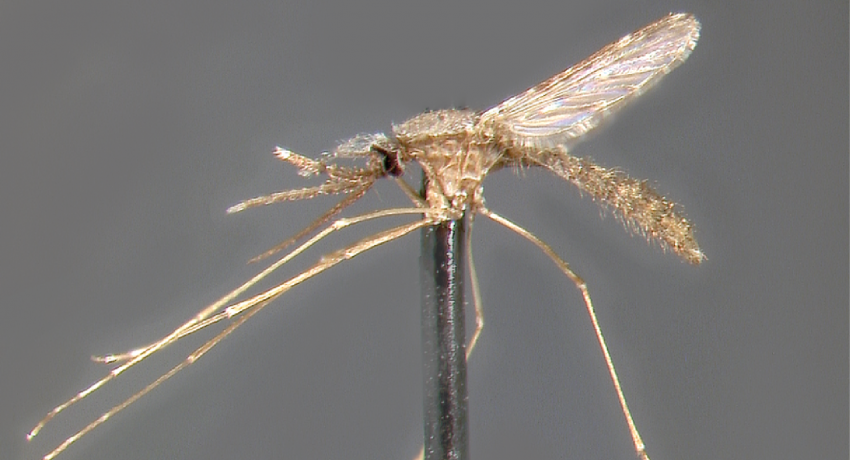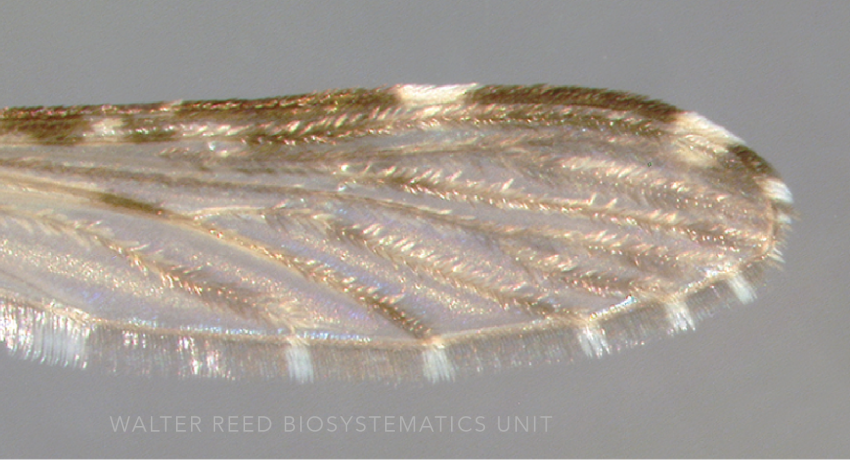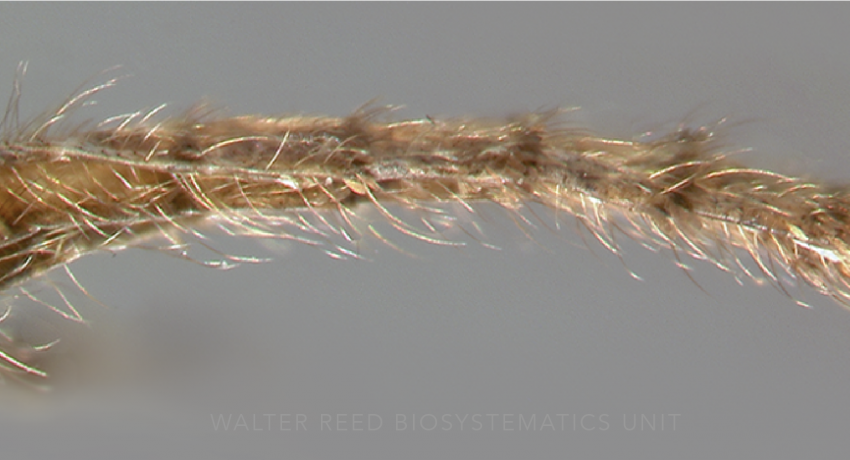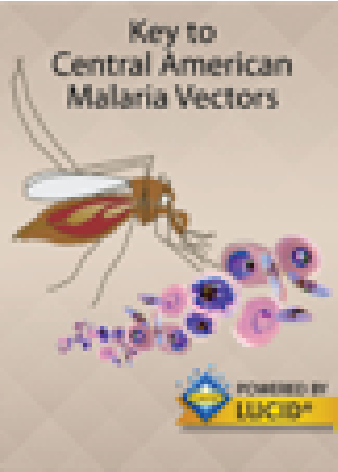NEOTROPICAL REGION
View Anopheles albitarsis group taxonomic timeline
Etymology: not stated [white foot (L); refers to white tarsal markings, especially]
Anopheles albitarsis is the name-bearing species for the Albitarsis Complex, Albitarsis Group, and Albitarsis Series of the Argyritarsis Section. There are currently 10 proposed members of the Albitarsis Complex; five formally described taxa: An. albitarsis s.s., An. deaneorum Rosa-Freitas, An. janconnae Wilkerson & Sallum, An. marajoara Galvão & Damasceno, and An. oryzalimnetes Wilkerson & Motoki. In addition, five novel taxa—species (F, G, I and lineages H and J) have been confirmed in our laboratory. Additional novel genetic lineages are recognized in An. marajoara (lineages 1 and 2), and An. sp. nr. janconnae, suggesting more work is needed to elucidate all component taxa across its range. Together with An. braziliensis, members of the Albitarsis Complex are easily recognized by a unique pair of white scale stripes on sternum I (S-1). Anopheles janconnae, An. albitarsis F & An. albitarsis I occur north of the Amazon, whereas all other taxa appear to be restricted to south of the Amazon Basin.
Type locality: Baradero, Buenos Aires, Argentina
Type depository: Instituto Oswaldo Cruz, Rio de Janeiro, Brazil (IOC)
DIAGNOSTIC CHARACTERS (Click photos to view; mouse over and click large photo to zoom in.)
ADULT (illustrated): Head: Palpomere MPlp4 with at least some white or cream-colored scales on mediolateral surface. Abdomen: Abdominal terga, at least segments II–VII-Te, covered with scales; posterolateral scale tufts absent from II-Te, and often III-Te and IV-Te; sternum I (I-S) with 2 longitudinal lines of white scales. Legs: Ta-III5 entirely white-scaled. Wing: Costa without sector pale spot; accessory sector pale spot c. 0.4 from wing base, conspicuously closer to sector pale than to subcostal pale spot.
LARVA (not illustrated): Head: Seta 3-C with short aciculae [all Albitarsis group species except deaneorum], branched distally [deaneorum]. Thorax: Setae 1–3-P usually inserted on common tubercle. Abdominal segments: Seta 1 palmate leaflets smooth-sided; seta 6-IV,V single.
TAXONOMIC KEYS
Roth 1944
Deane, L.M. et al. 1946
Causey et al. 1946
Deane, M.P. et al. 1946
Sallum, et al. 2020
![]()
Anopheles – Central America – Adult
![]()
Anopheles – Central America – Larva
![]()
WRBU - Genera - Global - Adult
![]()
WRBU - Genera - Global - Larva
Exemplar DNA sequences
An. albitarsis s.s. COI: KJ492407–432
An. albitarsis F COI: JQ614998–5041
An. albitarsis G COI: JQ615042–146
An. albitarsis H COI: KJ492406–677
An. albitarsis I COI: JQ615189–200
An. deaneorum COI: KJ492739–771
An. janconnae COI: JQ615347–441
An. marajoara COI: KJ011940–999
An. oryzalimnetes COI: KJ492830–KJ492894
BIONOMICS
Adults
Anopheles albitarsis s.s. and An. oryzalimnetes are predominantly zoophilic and not implicated in malaria transmission. Anopheles deaneorum, An. janconnae and An. marajoara are highly anthropophilic, endophagic, and are proven regional malaria vectors in various regions of Brazil.
DISTRIBUTION NOTES
Argentina, Bolivia, Brazil, Colombia, Costa Rica, Guatemala, French Guiana, Guyana, Jamaica, Panama, Paraguay, Peru, Trinidad & Tobago, United States (continental), Uruguay, Venezuela.
Molecularly confirmed distributions include: An. albitarsis (northern Argentina, southern Brazil & Paraguay), An. deaneorum Rosa-Freitas (southwestern Brazil), An. janconnae Wilkerson & Sallum (northern Brazil), An. marajoara Galvão & Damasceno (central Brazil), An. oryzalimnetes Wilkerson & Motoki (Brazil, Paraguay), An. albitarsis species F (Colombia, Trinidad, Venezuela), species G (Brazil), species I (Colombia, Venezuela), species J (Brazil) and lineage H (Brazil).
Map shows distribution of An. albitarsis s.l.
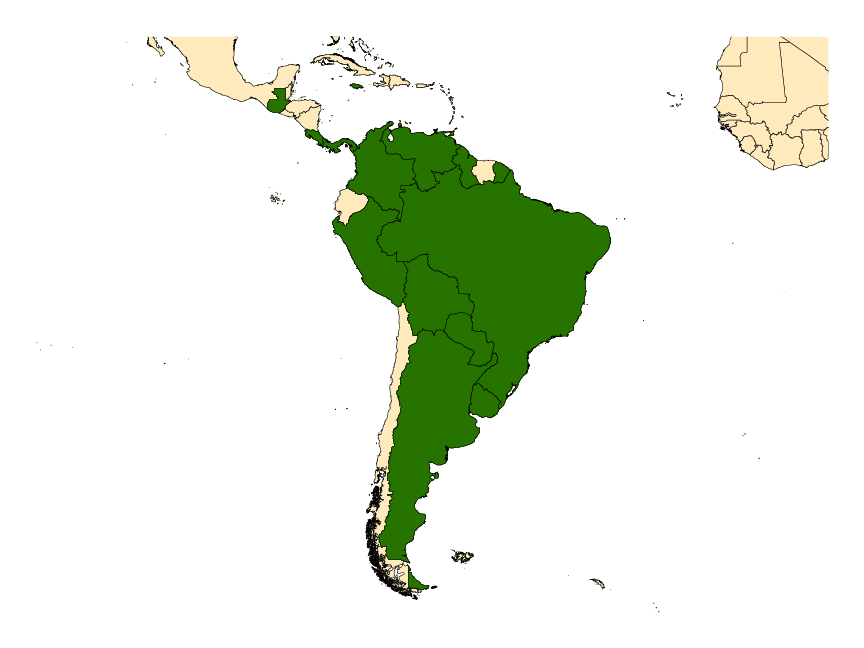
WRBU VECTOR HAZARD REPORTS
None; View other WRBU Vector Hazard Reports
Available GIS Models
An_albitarsis_ss_Foley_1 South & Central America
An_albitarsis_Nyari_1 South & Central America
IMPORTANT REFERENCES (full citations below)
Lynch Arribálzaga 1878: 150 (F)
Senevet 1934: 45 (P*)
Pinto 1939: 345 (M*, F*, P*, L*, E)
Rozeboom 1942a: 238 (E*; taxonomy)
Ross & Roberts 1943a: 31 (M*, F*, L*)
Roth 1944: 97 (M*), 107-110 (M genitalia keys)
Cova-García 1946: Fig. 1 (E*), 31 (L*), 83 (F*), 118 (M*)
Deane, L.M. et al. 1946 (F*, key, bionomics; NE Brazil & Amazonas; s.l.)
Causey et al. 1946 (M*, key ; NE Brazil & Amazonas; s.l.)
Deane, M.P. et al. 1946 (L*, key, bionomics; NE Brazil & Amazonas; s.l.)
Romeo Viamonte & Castro 1951: 321 (F*)
García & Casal 1965(1964)a: 6 (P*)
Kreutzer et al. 1976: 473 (chromosomes*)
Patriota Nascimento & Lourenço-de-Oliveira 1984 (taxonomy; s.l.)
Rosa-Freitas & Deane 1989b: 289 (neotype designation)
Rosa-Freitas et al. 1990 (molecular taxonomy; s.l.)
Calderón et al. 1995 (distribution; Peru)
Wilkerson & Parsons et al. 1995 (molecular taxonomy; s.l.)
Monnerat et al. 1999 (E*; s.l.)
Krzywinski et al. 2001 a,b (mtDNA, phylogenetics; s.l.)
Wilkerson et al. 2005 (phylogenetics; s.l.)
Li & Wilkerson 2005 (molecular taxonomy; s.l.)
Lehr et al. 2005 (molecular taxonomy, phylogenetics; s.l.)
Brochera et al. 2007 (sensu lato; albitarsis species F)
Li & Wilkerson 2007 (molecular taxonomy; s.l.)
Motoki et al. 2009 (M*, F, P*, L*)
Sinka et al. 2010: 72 (Albitarsis Complex; bionomics review, distribution, niche model)
Ruiz-Lopez et al. 2012 (molecular taxonomy; s.l.)
Foley et al. 2014 (distribution, bionomics, model; s.l.).
Motoki, Linton, Conn, et al. 2020 (molecular taxonomy; albitarsis species H, J)
Sallum, et al. 2020 (keys F, M, L)
CURRENT SYNONYMS
syn. limai Galvão & Lane
1937b: 227 (A, E*; as variety). Type locality: Suburbs of Pinheiros & Butantan, São Paulo, Brazil (NE). References: Lane 1953: 244 (synonymy); Belkin et al. 1971: 4 (taxonomy).
syn. imperfectus Corrêa & Ramos
1943: 246 (F; as subspecies). Type locality: Vera Cruz, São Paulo, Brazil (FH). References: Lane 1953: 244 (synonymy); Belkin et al. 1971: 4 (taxonomy).
CITED REFERENCES
Belkin, J.N., Schick, R.X., & Heinemann, S.J. (1971). Mosquito studies (Diptera, Culicidae). XXV. Mosquitoes originally described from Brazil. Contributions of the American Entomological Institute, 7(5), 1–64.
Brochero, H.H.L., Li, C., & Wilkerson, R.C. (2007). A newly recognized species in the Anopheles (Nyssorhynchus) albitarsis complex (Diptera: Culicidae) from Puerto Carreño, Colombia. American Journal of Tropical Medicine and Hygiene, 76(6), 1113–1117.
Calderon, G., Fernandez, R., & Valle, J. (1995). Especiés de la fauna anofelina, su distribución y algunas consideraciones sôbre su abundancia e infectividad en el Peru. Revista Peruana de Epidmiologia, 8, 19.
Causey, O.R., Deane, L.M., & Deane, M.P. (1946). An illustrated key by male genitalic characteristics for the identification of thirty-four species of Anophelini from the northeast and Amazon regions of Brazil, with a note on dissection technique. American Journal of Hygiene Monograph Series, 18, 21–31.
Corrêa, R.R., & Ramos, A.S. (1943). Descrição de uma nova sub-espécie de anofelino do sub-género Nyssorhynchus Blanchard, 1902 (Diptera, Culicidae). Revista Paulista de Medicina, 22, 246–248.
Deane, L.M., Causey, O.R., & Deane, M.P. (1946). I. An illustrated key by adult female characteristics for the identification of thirty-five species of Anophelini, with notes on the malaria vectors (Diptera, Culicidae). In Studies on Brazilian anophelines from the northeast and Amazon regions (pp. 1–18). Baltimore: The Johns Hopkins Press.
Deane, M.P., Causey, O. R., & Deane, L.M. (1946). III. An illustrated key by larval characteristics for the identification of thirty-two species of Anophelini, with descriptions of two larvae. In Studies on Brazilian anophelines from the northeast and Amazon regions (pp. 33–50). Baltimore: The Johns Hopkins Press.
Foley, D.H., Linton, Y.-M., Ruiz-Lopez, J.F., Conn, J.E., Sallum, M.A.M., Povoa, M.M., . . . Wilkerson, R.C. (2014). Geographic distribution, evolution, and disease importance of species within the Neotropical Anopheles albitarsis group (Diptera, Culicidae). Journal of Vector Ecology, 39(1), 168–181.
Galvão, A.L.A., & Lane, J. (1937b). Nota sôbre os Nyssorhynchus de S. Paulo. VII. Estudo sôbre as variedades deste grupo com a descrição de Anopheles (Nyssorhynchus) albitarsis Arrib., 1878 var. limai n. var. Annaes da Faculdade de Medicina de São Paulo, 13, 211–238.
García, M., & Casal, O.H. (1965a). Descripción de tres pupas de mosquitos neotropicales (Diptera, Culicidae). Revista de la Sociedad Entomologica Argentina, 27(1964), 5–10
Hay, S.I., Sinka, M.E., Okara, R.M., Kabaria, C.W., Mbithi, P.M., Tago, C.C., …Godfray, H.C.J. (2010). Developing global maps of the dominant Anopheles vectors of human malaria. PLoS Medicine, 7(2): e1000209.
Kreutzer, R.D., Kitzmiller, J.B., & Rabbani, M.G. (1976). Cytogenetically distinguishable sympatric and allopatric populations of the mosquito Anopheles albitarsis. Acta Amazonica, 6(4), 473–481.
Krzywinski, J., Wilkerson, R.C., & Besansky, N J. (2001a). Evolution of mitochondrial and ribosomal gene sequences in Anophelinae (Diptera; Culicidae): implications for phylogeny reconstruction. Molecular Phylogenetics and Evolution, 18(3), 479–487.
Krzywinski, J., Wilkerson, R.C., & Besansky, N.J. (2001b). Toward understanding Anophelinae (Diptera: Culicidae) phylogeny: Insights from nuclear single-copy genes and weight of evidence. Systematic Biology, 50(4), 540–556.
Lane, J. (1953). Neotropical Culicidae (Vols. I, II). São Paulo: University of São Paulo.
Lehr, M.A., Kilpatrick, C.W., Wilkerson, R.C., & Conn, J.E. (2005). Cryptic species in the Anopheles (Nyssorhynchus) albitarsis (Diptera: Culicidae) complex: Incongruence between random amplified polymorphic DNA-polymerase chain reaction identification and analysis of mitochondrial DNA COI gene sequences. Annals of the Entomological Society of America, 98(6), 908–917.
Li, C., & Wilkerson, R.C. (2005). Identification of Anopheles (Nyssorhynchus) albitarsis complex species (Diptera: Culicidae) using rDNA internal transcribed spacer 2-based polymerase chain reaction primes. Memórias do Instituto Oswaldo Cruz, 100, 495–500.
Li, C., & Wilkerson, R.C. (2007). Intragenomic rDNA ITS2 variation in the Neotropical Anopheles (Nyssorhynchus) albitarsis complex (Diptera: Culicidae). Journal of Heredity, 98, 51–59.
Lynch Arribalzaga, F. (1878). Descripción de tres nuevos Culicidae de Buenos Aires. Nat argent, 1, 149–152.
Monnerat, A.T., Soares, M.J., Lima, J.B.P., Rosa-Freitas, M.G., & Valle, D. (1999). Anopheles albitarsis eggs: ultrastructural analysis of chorion layers after permeabilization. Journal of Insect Physiology, 45(10), 915–922.
Motoki, M.T., Wilkerson, R.C., & Sallum, M.A.M. (2009). The Anopheles albitarsis complex with the recognition of Anopheles oryzalimnetes Wilkerson and Motoki, n. sp. and Anopheles janconnae Wilkerson and Sallum, n. sp. (Diptera: Culicidae). Memórias do Instituto Oswaldo Cruz, 104(6), 823–850.
Motoki, M. T., Linton, Y. M., Conn, J. E., Ruiz-Lopez, F., & Wilkerson, R. C. (2020). Phylogenetic Network of Mitochondrial COI Gene Sequences Distinguishes 10 Taxa Within the Neotropical Albitarsis Group (Diptera: Culicidae), Confirming the Separate Species Status of Anopheles albitarsis H (Diptera: Culicidae) and Revealing a Novel Lineage, Anopheles albitarsis J. Journal of Medical Entomology.
Patriota Nascimento, L., & Lourenço de Oliveira, A.C. (1984). Complexo Anopheles (Nyssorhynchus) albitarsis: Impossibilidade de separa - lo em duas subespécies A. albitarsis albitarsis e A. albitarsis domesticus (Diptera Culicidae). Revista Brasileira de Biologia, 44(4), 461–465.
Pinto, C. (1939). Disseminacão da malaria pela aviacão; biologia do Anopheles gambiae e outros anofelineos do Brasil. Memórias do Instituto Oswaldo Cruz, 34, 293 430.
Romeo Viamonte, J.M., & Castro, M. (1951). Estudio de la morfología de la armadura faringea de algunos anofilinos. (Dipt. Culic.). Revista de Sanidad e Higiene Pública, 25, 313–330.
Rosa-Freitas, M G., & Deane, L.M. (1989b). The neotype of Anopheles albitarsis (Diptera: Culicidae). Memórias do Instituto Oswaldo Cruz, 84(3), 289–302.
Rosa-Freitas, M.G., Deane, L.M., & Momen, H. (1990). A morphological, isoenzymatic and behavioural study of ten populations of Anopheles (Nyssorhynchus) albitarsis Lynch-Arribalzaga, 1878 (Diptera: Culicidae) including from the type-locality - Baradero, Argentina. Memórias do Instituto Oswaldo Cruz, 85(3), 275–289.
Ross, E.S., & Roberts, H.R. (1943a). Mosquito atlas. Part I. The Nearctic Anopheles, important malaria vectors of the Americas, and Aedes aegypti, Culex quinquefasciatus. Contributions of the American Entomological Institute.
Ross, E.S., & Roberts, H.R. (1943a). Mosquito atlas. Part I. The Nearctic Anopheles, important malaria vectors of the Americas, and Aedes aegypti, Culex quinquefasciatus. Contributions of the American Entomological Institute.
Roth, L.M. (1944). A key to the Anopheles of the southeastern United States, by male genitalia (Diptera, Culicidae). The American Midland Naturalist, 31, 96–110.
Rozeboom, L.E. (1942a). Subspecific variations among Neotropical Anopheles mosquitoes, and their importance in the transmission of malaria. American Journal of Tropical Medicine and Hygiene, 22, 235–255.
Ruiz-Lopez, F., Wilkerson, R.C., Conn, J.E., McKeon, S.N., Levin, D.M., Quinones, M.L., . . . Linton, Y.-M. (2012). DNA barcoding reveals both known and novel taxa in the Albitarsis Group (Anopheles: Nyssorhynchus) of Neotropical malaria vectors. Parasites and Vectors, 5, 44.
Sallum, M.A.M., Obando, R.G., Carrejo, N. et al. Identification key to the Anopheles mosquitoes of South America (Diptera: Culicidae). Parasites and Vectors 13, 542 (2020). https://www.biomedcentral.com/collections/id-keys-anopheles
Senevet, G. (1934). Contribution a l'étude des nymphes d'anophelines (4e Memoire). Archives de l'Institut Pasteur d'Algérie, 12, 29–76.
Wilkerson, R.C., Foster, P.G., Li, C., & Sallum, M.A.M. (2005). Molecular phylogeny of neotropical Anopheles (Nyssorhynchus) albitarsis complex (Diptera; Culicidae). Annals of the Entomological Society of America, 98, 918–925.
CITE THIS PAGE
Walter Reed Biosystematics Unit (Year). Anopheles albitarsis species page. Walter Reed Biosystematics Unit Website, http://wrbu.si.edu/vectorspecies/mosquitoes/albitarsis, accessed on [date (e.g. 03 February 2020) when you last viewed the site].

